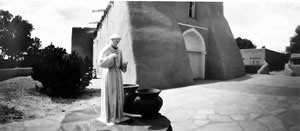“Pinhole Photographs”
The black and white photography of Jeffrey Martz is on exhibit in College of Eastern Utah’s Gallery East until December 15.
Martz titles his exhibit “Pinhole Photographs” which features 22 recent photos taken on the West Coast, in New York, New Mexico, France, Italy and Germany.
He describes his photography process as being made from hand holding a Leica M6 .58 camera outfitted with a pinhole-modified body cap. The aperture is approximately F/180 and the pinhole angle of view is 22 mm.
He prints his negative on a variety of double-weight fiber-based papers.

The black and white photography of Jeffrey Martz is on exhibit in College of Eastern Utah’s Gallery East until December 15.
Martz titles his exhibit “Pinhole Photographs” which features 22 recent photos taken on the West Coast, in New York, New Mexico, France, Italy and Germany.
He describes his photography process as being made from hand holding a Leica M6 .58 camera outfitted with a pinhole-modified body cap. The aperture is approximately F/180 and the pinhole angle of view is 22 mm.
He prints his negative on a variety of double-weight fiber-based papers.
Gallery curator Robert De Groff is a personal friend of Martz. “I have known Jeff for 16-plus years. He and I were undergraduates at USU.” Martz earned his bachelor’s of fine arts degree and master’s of fine arts degrees from Utah State University, and teaches photography at Sir Francis Drake High School in Marin County, Calif.
“I had an interesting conversation with my design class about the photographs yesterday,” DeGroff explained. “A common misconception is that the photographs are ‘wrong’ because they are not ‘in focus.’ Since there are no lenses involved in pinhole photography, there is, technically speaking, no focus. There is also no depth of field, or, if you prefer, there is infinite depth of field. In other words, an object an inch from the aperture of the camera will have the same sharpness (or lack of sharpness) as an object a mile away.
“This sometimes produces a rather unsettling ambiguity of scale in the work. For example, what we may at first glance take as a lone stalk of grain in a field turns out to be a lone tree in a huge clear cut forest. Because of these peculiar characteristics of pinhole photography, the images often appear to break established photographic rules.
“Since we have been so conditioned by lens-based photography to accept razor-sharp images as the only ‘right’ appearance for a photograph to have, it might be tempting to see Jeff’s work as falling just short of the mark. Nothing could be further from the truth. Jeff is a consummate craftsman, and in the past has produced large format photographs with incredible detail and clarity.
“The body of work currently on display [in Gallery East] is a conscious departure from the standard sharp mode of photography into a softer, more pictorial way of seeing.
“Jeff’s artist’s statement, written–and this also is no accident–in pencil, describes his thoughts on the process beautifully. It is on display at the entrance of Gallery East,” DeGroff said.
Gallery East is located in the SAC Building on CEU’s campus. The exhibit is supported by CEU, Utah Arts Council and the National Endowment for the Arts. The exhibit is open to the public weekdays from 9 a.m. to 5 p.m. at no cost.




